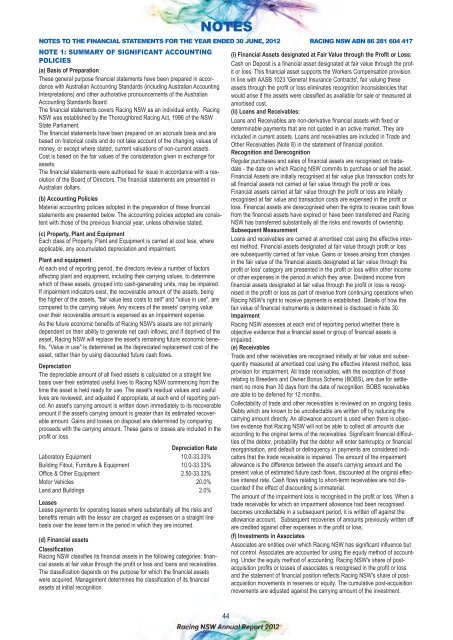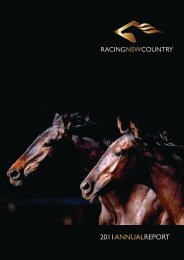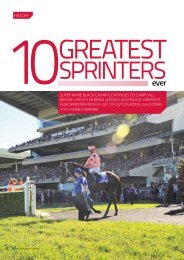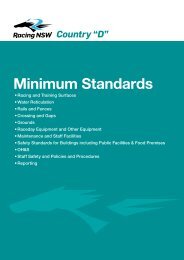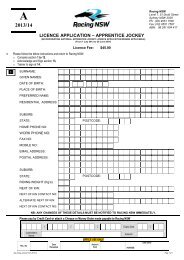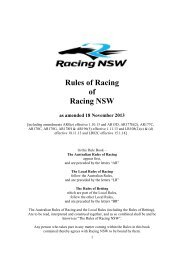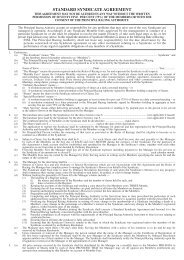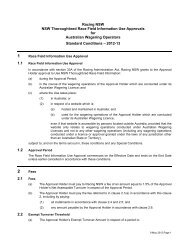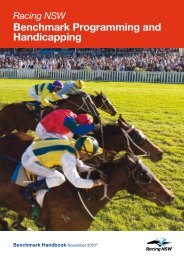2012 Annual Report - Racing NSW
2012 Annual Report - Racing NSW
2012 Annual Report - Racing NSW
You also want an ePaper? Increase the reach of your titles
YUMPU automatically turns print PDFs into web optimized ePapers that Google loves.
NOTES<br />
NOTES TO THE FINANCIAL STATEMENTS FOR THE YEAR ENDED 30 JUNE, <strong>2012</strong> RACING <strong>NSW</strong> ABN 86 281 604 417<br />
NOTE 1: SUMMARY OF SIGNIFICANT ACCOUNTING<br />
POLICIES<br />
(a) Basis of Preparation<br />
These general purpose financial statements have been prepared in accordance<br />
with Australian Accounting Standards (including Australian Accounting<br />
Interpretations) and other authorative pronouncements of the Australian<br />
Accounting Standards Board.<br />
The financial statements covers <strong>Racing</strong> <strong>NSW</strong> as an individual entity. <strong>Racing</strong><br />
<strong>NSW</strong> was established by the Thoroughbred <strong>Racing</strong> Act, 1996 of the <strong>NSW</strong><br />
State Parliament.<br />
The financial statements have been prepared on an accruals basis and are<br />
based on historical costs and do not take account of the changing values of<br />
money, or except where stated, current valuations of non-current assets.<br />
Cost is based on the fair values of the consideration given in exchange for<br />
assets.<br />
The financial statements were authorised for issue in accordance with a resolution<br />
of the Board of Directors. The financial statements are presented in<br />
Australian dollars.<br />
(b) Accounting Policies<br />
Material accounting policies adopted in the preparation of these financial<br />
statements are presented below. The accounting policies adopted are consistent<br />
with those of the previous financial year, unless otherwise stated.<br />
(c) Property, Plant and Equipment<br />
Each class of Property, Plant and Equipment is carried at cost less, where<br />
applicable, any accumulated depreciation and impairment.<br />
Plant and equipment<br />
At each end of reporting period, the directors review a number of factors<br />
affecting plant and equipment, including their carrying values, to determine<br />
which of these assets, grouped into cash-generating units, may be impaired.<br />
If impairment indicators exist, the recoverable amount of the assets, being<br />
the higher of the assets, "fair value less costs to sell" and "value in use", are<br />
compared to the carrying values. Any excess of the assets' carrying value<br />
over their recoverable amount is expensed as an impairment expense.<br />
As the future economic benefits of <strong>Racing</strong> <strong>NSW</strong>'s assets are not primarily<br />
dependent on their ability to generate net cash inflows, and if deprived of the<br />
asset, <strong>Racing</strong> <strong>NSW</strong> will replace the asset's remaining future economic benefits,<br />
"Value in use" is determined as the depreciated replacement cost of the<br />
asset, rather than by using discounted future cash flows.<br />
Depreciation<br />
The depreciable amount of all fixed assets is calculated on a straight line<br />
basis over their estimated useful lives to <strong>Racing</strong> <strong>NSW</strong> commencing from the<br />
time the asset is held ready for use. The asset's residual values and useful<br />
lives are reviewed, and adjusted if appropriate, at each end of reporting period.<br />
An asset's carrying amount is written down immediately to its recoverable<br />
amount if the asset's carrying amount is greater than its estimated recoverable<br />
amount. Gains and losses on disposal are determined by comparing<br />
proceeds with the carrying amount. These gains or losses are included in the<br />
profit or loss.<br />
Depreciation Rate<br />
Laboratory Equipment 10.0-33.33%<br />
Building Fitout, Furniture & Equipment 10.0-33.33%<br />
Office & Other Equipment 2.50-33.33%<br />
Motor Vehicles 20.0%<br />
Land and Buildings 2.0%<br />
Leases<br />
Lease payments for operating leases where substantially all the risks and<br />
benefits remain with the lessor are charged as expenses on a straight line<br />
basis over the lease term in the period in which they are incurred.<br />
(d) Financial assets<br />
Classification<br />
<strong>Racing</strong> <strong>NSW</strong> classifies its financial assets in the following categories: financial<br />
assets at fair value through the profit or loss and loans and receivables.<br />
The classification depends on the purpose for which the financial assets<br />
were acquired. Management determines the classification of its financial<br />
assets at initial recognition.<br />
(i) Financial Assets designated at Fair Value through the Profit or Loss:<br />
Cash on Deposit is a financial asset designated at fair value through the profit<br />
or loss. This financial asset supports the Workers Compensation provision.<br />
In line with AASB 1023 'General Insurance Contracts', fair valuing these<br />
assets through the profit or loss eliminates recognition inconsistencies that<br />
would arise if the assets were classified as available for sale or measured at<br />
amortised cost.<br />
(ii) Loans and Receivables:<br />
Loans and Receivables are non-derivative financial assets with fixed or<br />
determinable payments that are not quoted in an active market. They are<br />
included in current assets. Loans and receivables are included in Trade and<br />
Other Receivables (Note 8) in the statement of financial position.<br />
Recognition and Derecognition<br />
Regular purchases and sales of financial assets are recognised on tradedate<br />
- the date on which <strong>Racing</strong> <strong>NSW</strong> commits to purchase or sell the asset.<br />
Financial Assets are initially recognised at fair value plus transaction costs for<br />
all financial assets not carried at fair value through the profit or loss.<br />
Financial assets carried at fair value through the profit or loss are initially<br />
recognised at fair value and transaction costs are expensed in the profit or<br />
loss. Financial assets are derecognised when the rights to receive cash flows<br />
from the financial assets have expired or have been transferred and <strong>Racing</strong><br />
<strong>NSW</strong> has transferred substantially all the risks and rewards of ownership.<br />
Subsequent Measurement<br />
Loans and receivables are carried at amortised cost using the effective interest<br />
method. Financial assets designated at fair value through profit or loss<br />
are subsequently carried at fair value. Gains or losses arising from changes<br />
in the fair value of the 'financial assets designated at fair value through the<br />
profit or loss' category are presented in the profit or loss within other income<br />
or other expenses in the period in which they arise. Dividend income from<br />
financial assets designated at fair value through the profit or loss is recognised<br />
in the profit or loss as part of revenue from continuing operations when<br />
<strong>Racing</strong> <strong>NSW</strong>'s right to receive payments is established. Details of how the<br />
fair value of financial instruments is determined is disclosed in Note 30.<br />
Impairment<br />
<strong>Racing</strong> <strong>NSW</strong> assesses at each end of reporting period whether there is<br />
objective evidence that a financial asset or group of financial assets is<br />
impaired.<br />
(e) Receivables<br />
Trade and other receivables are recognised initially at fair value and subsequently<br />
measured at amortised cost using the effective interest method, less<br />
provision for impairment. All trade receivables, with the exception of those<br />
relating to Breeders and Owner Bonus Scheme (BOBS), are due for settlement<br />
no more than 30 days from the date of recognition. BOBS receivables<br />
are able to be deferred for 12 months.<br />
Collectability of trade and other receivables is reviewed on an ongoing basis.<br />
Debts which are known to be uncollectable are written off by reducing the<br />
carrying amount directly. An allowance account is used when there is objective<br />
evidence that <strong>Racing</strong> <strong>NSW</strong> will not be able to collect all amounts due<br />
according to the original terms of the receivables. Significant financial difficulties<br />
of the debtor, probability that the debtor will enter bankruptcy or financial<br />
reorganisation, and default or delinquency in payments are considered indicators<br />
that the trade receivable is impaired. The amount of the impairment<br />
allowance is the difference between the asset’s carrying amount and the<br />
present value of estimated future cash flows, discounted at the original effective<br />
interest rate. Cash flows relating to short-term receivables are not discounted<br />
if the effect of discounting is immaterial.<br />
The amount of the impairment loss is recognised in the profit or loss. When a<br />
trade receivable for which an impairment allowance had been recognised<br />
becomes uncollectable in a subsequent period, it is written off against the<br />
allowance account. Subsequent recoveries of amounts previously written off<br />
are credited against other expenses in the profit or loss.<br />
(f) Investments in Associates<br />
Associates are entities over which <strong>Racing</strong> <strong>NSW</strong> has significant influence but<br />
not control. Associates are accounted for using the equity method of accounting.<br />
Under the equity method of accounting, <strong>Racing</strong> <strong>NSW</strong>'s share of postacquisition<br />
profits or losses of associates is recognised in the profit or loss<br />
and the statement of financial position reflects <strong>Racing</strong> <strong>NSW</strong>'s share of postacquisition<br />
movements in reserves or equity. The cumulative post-acquisition<br />
movements are adjusted against the carrying amount of the investment.<br />
44


